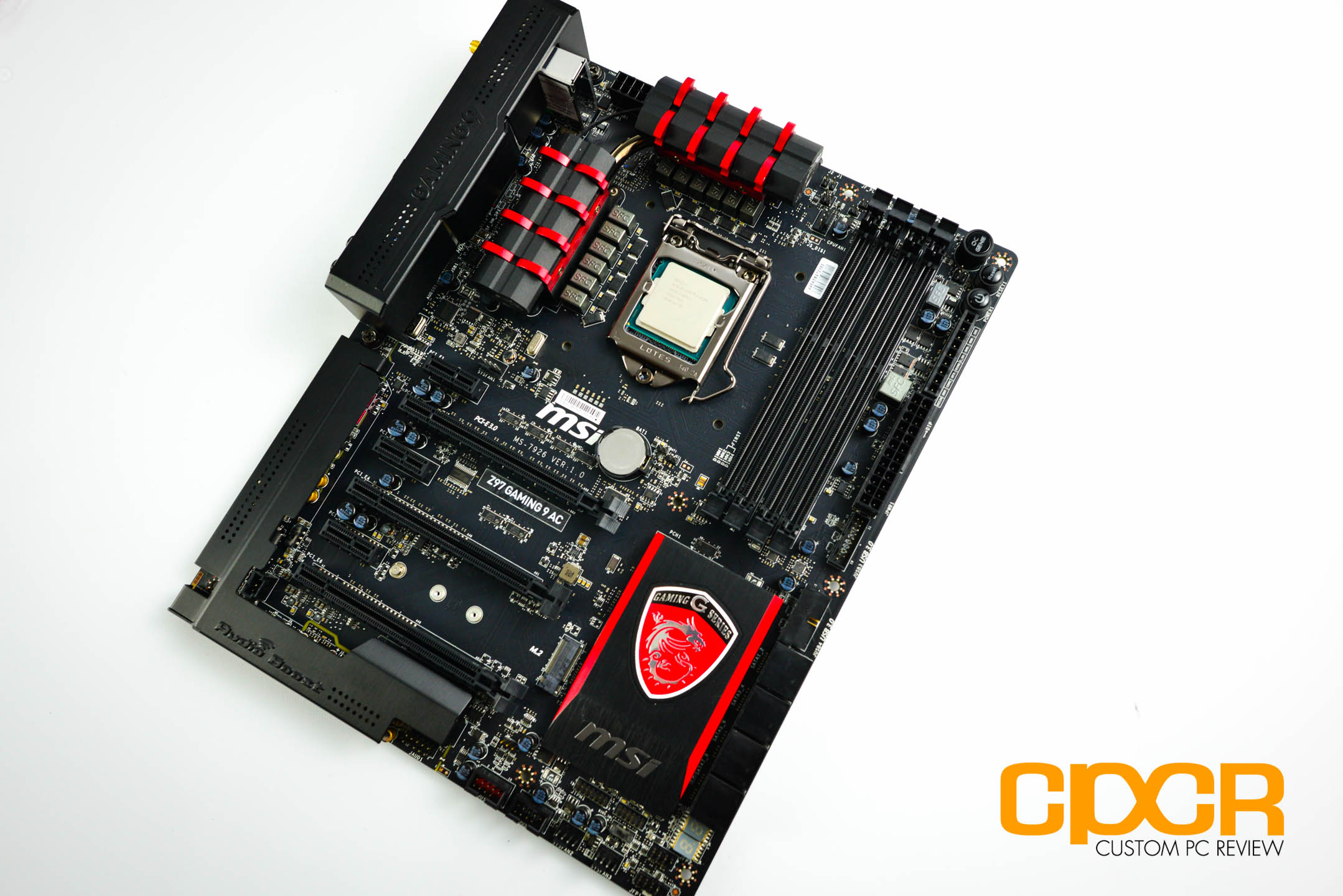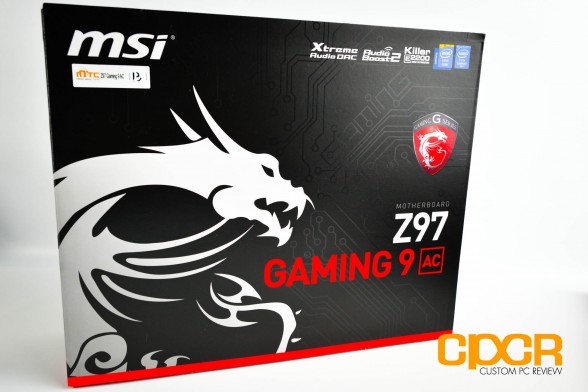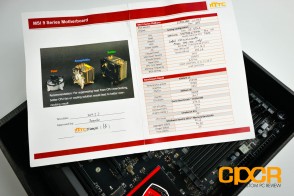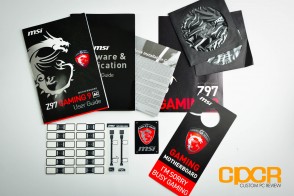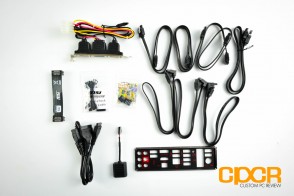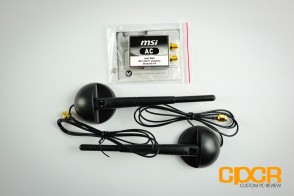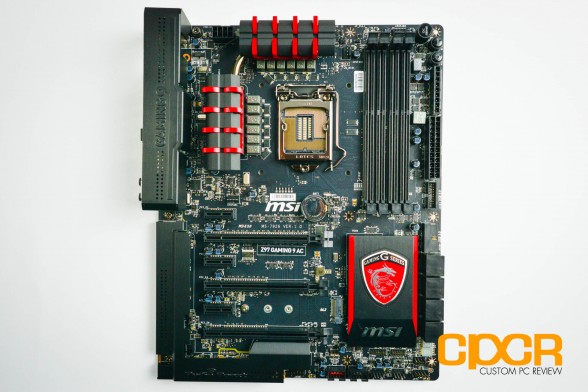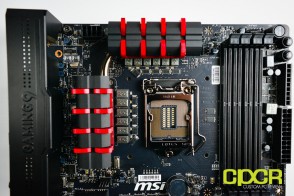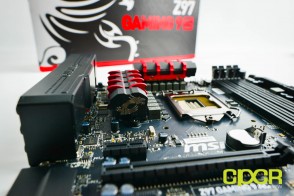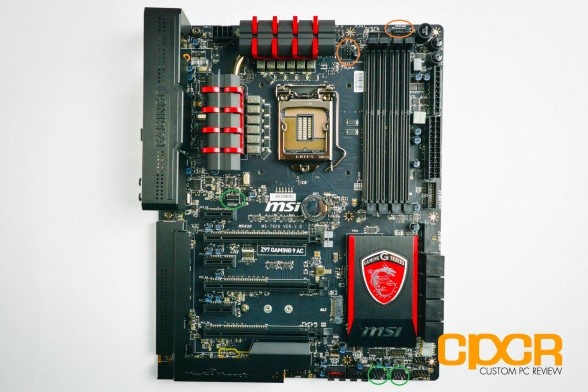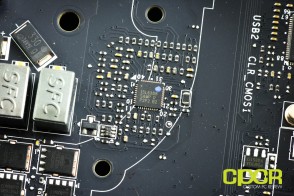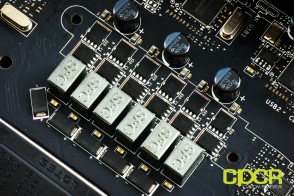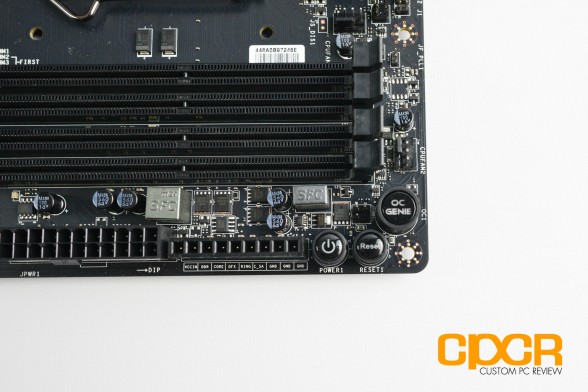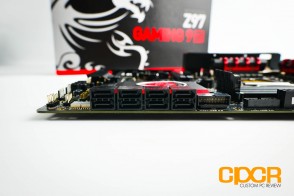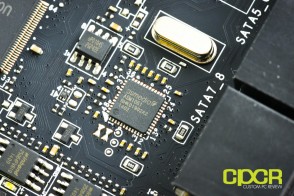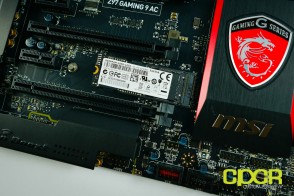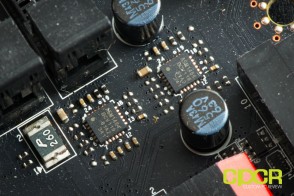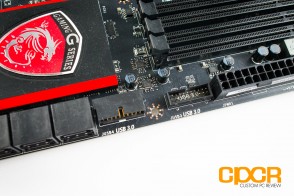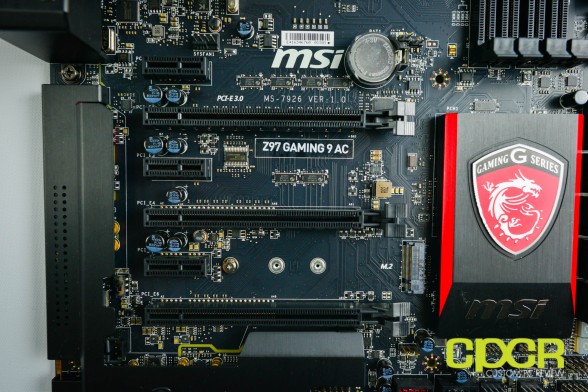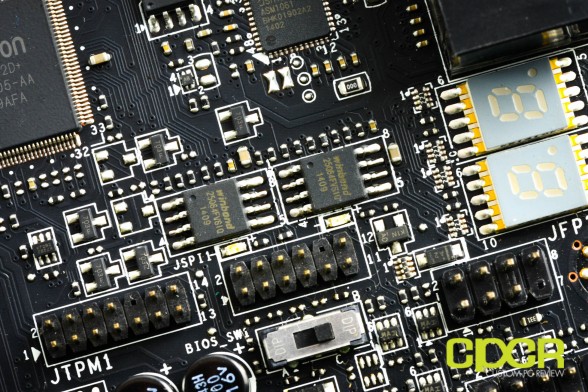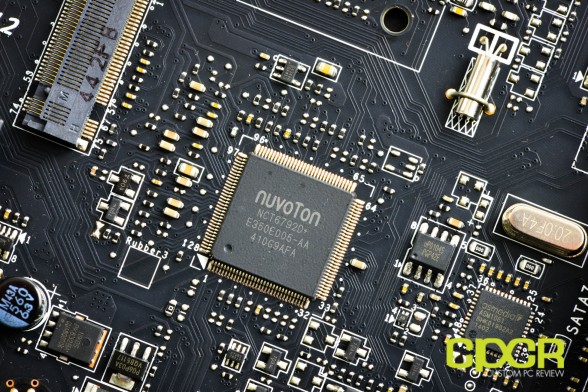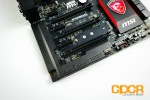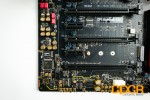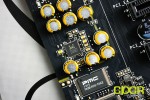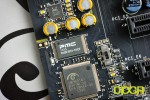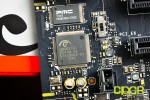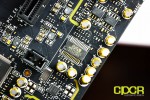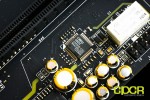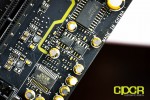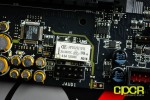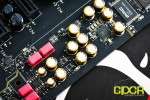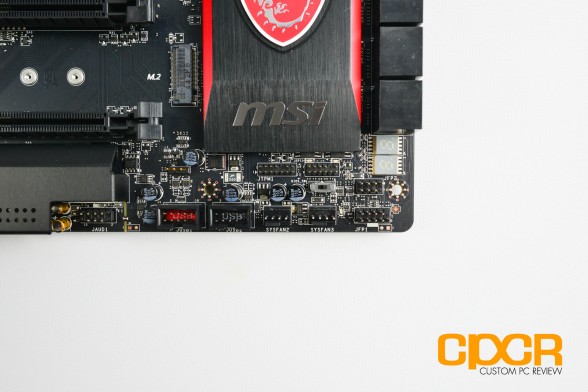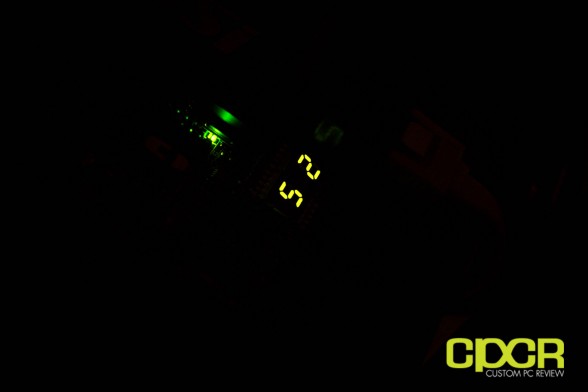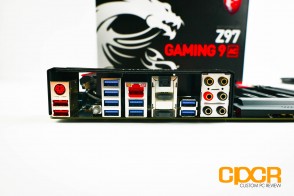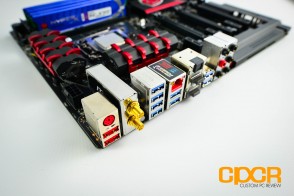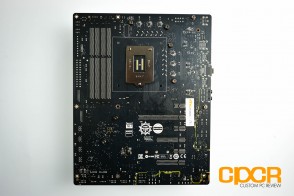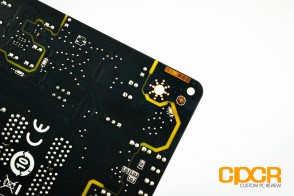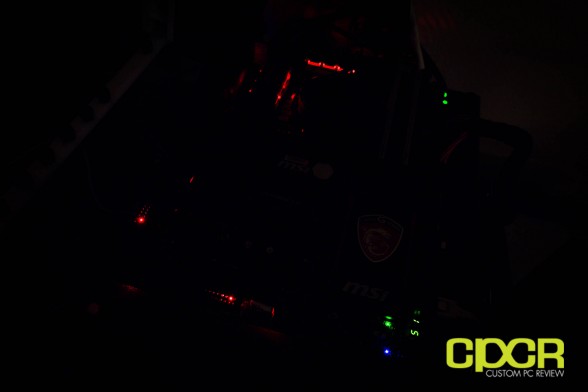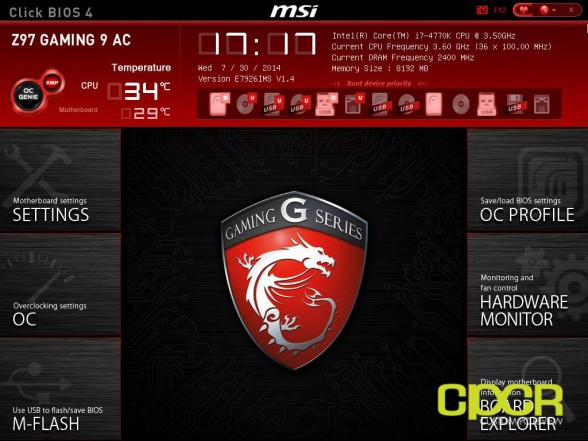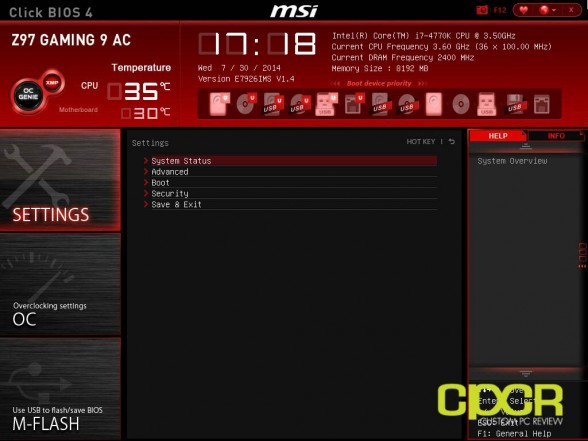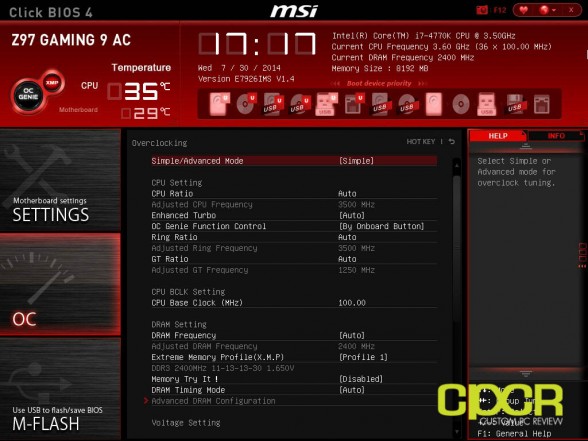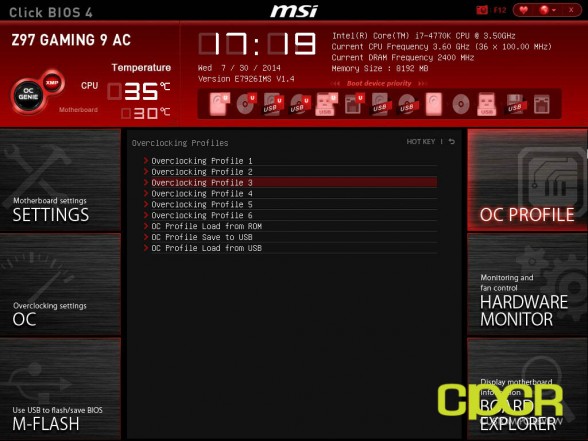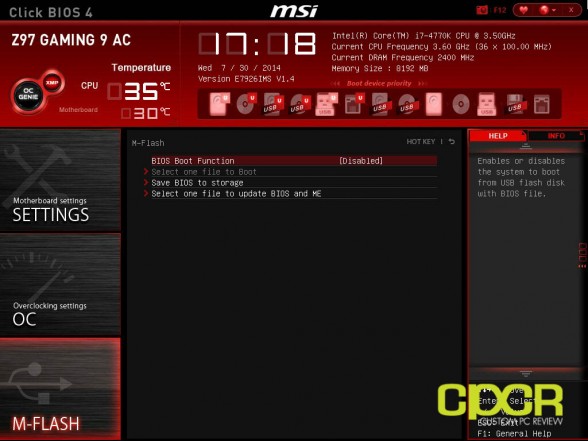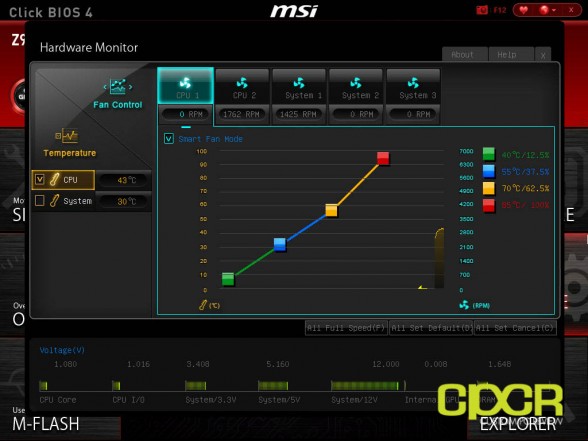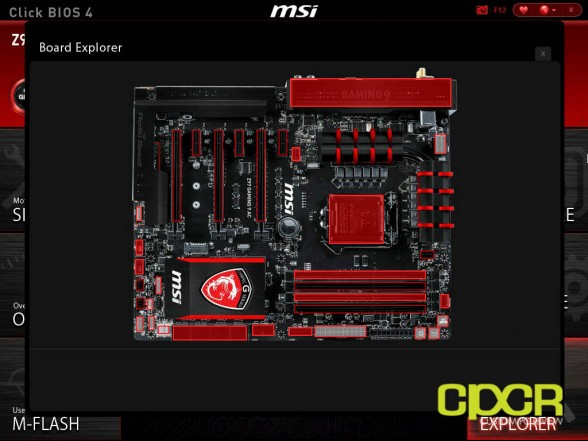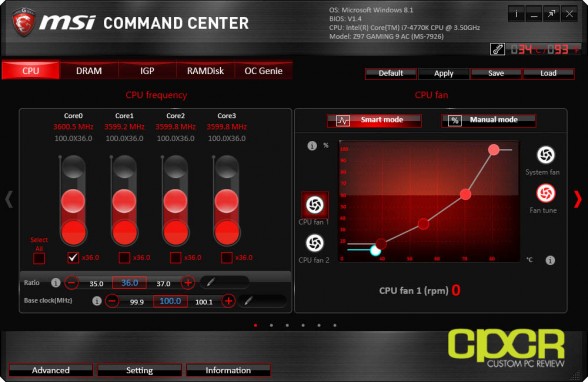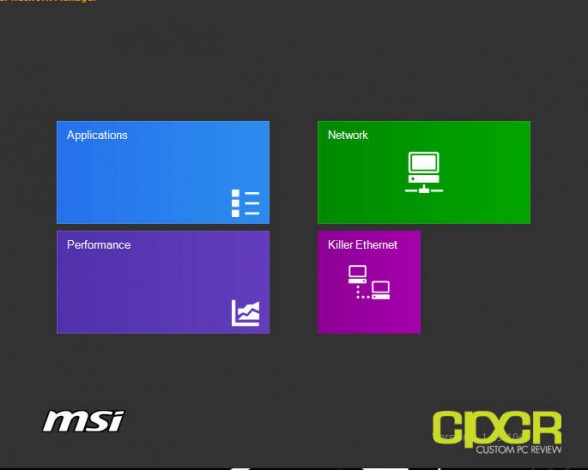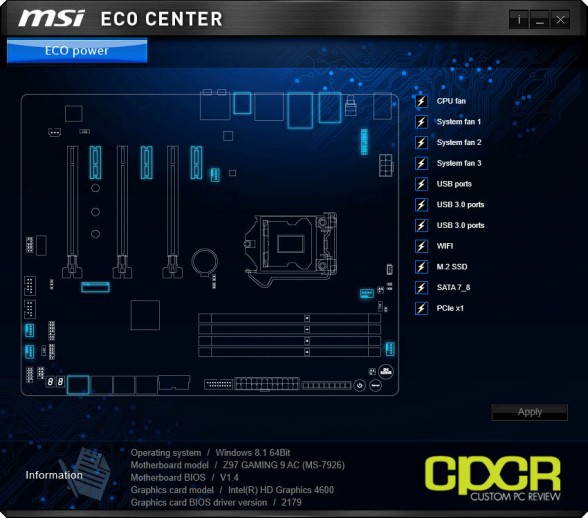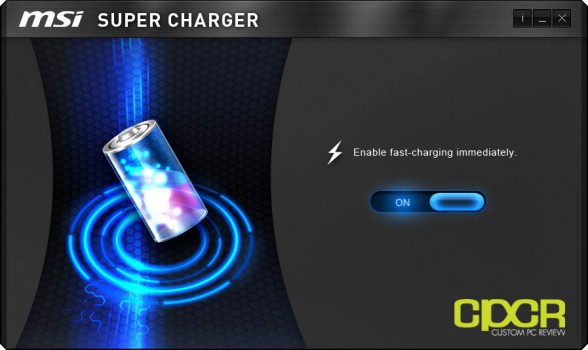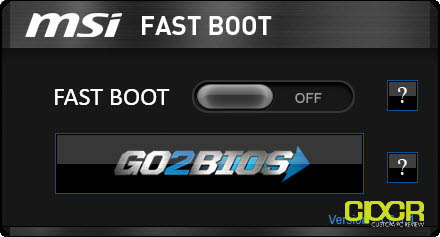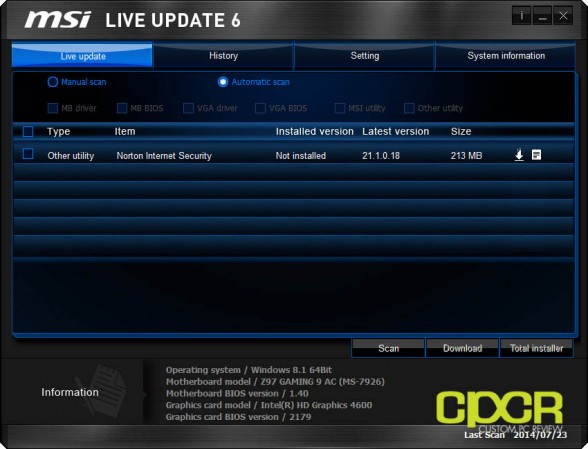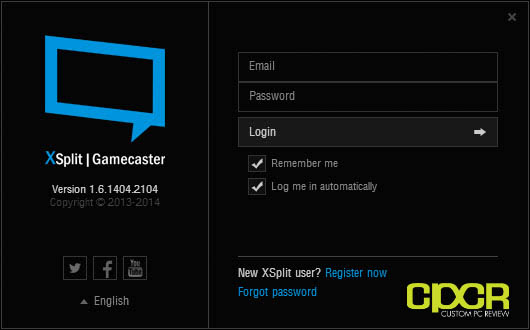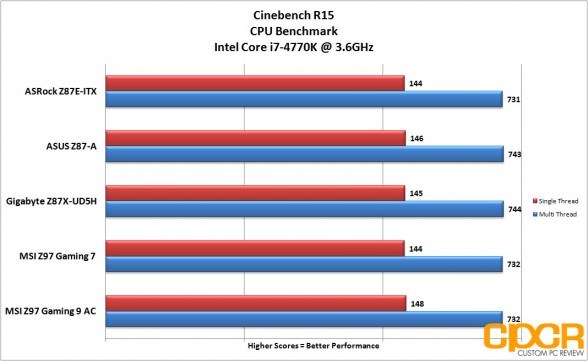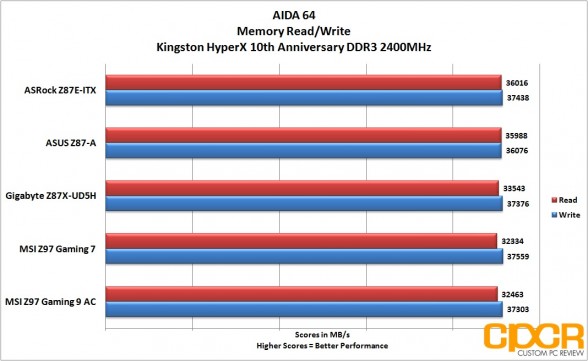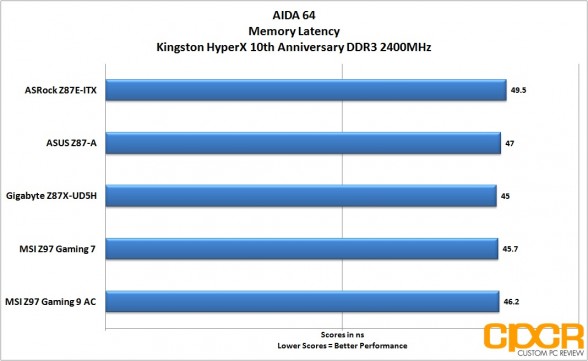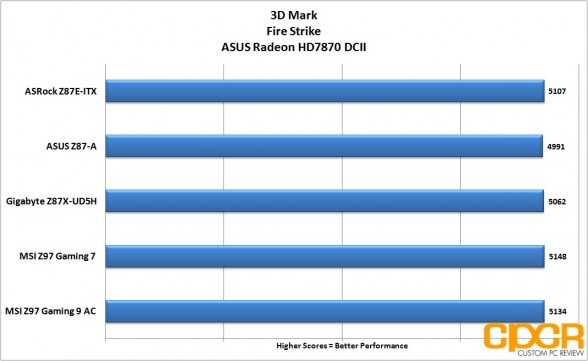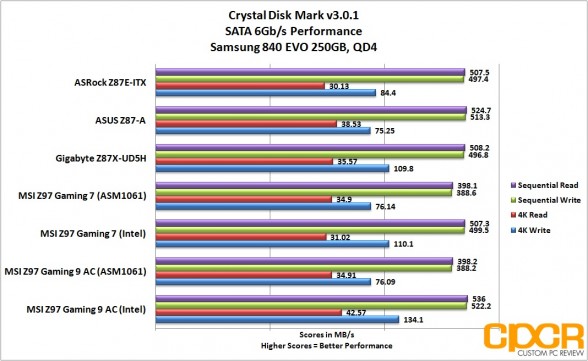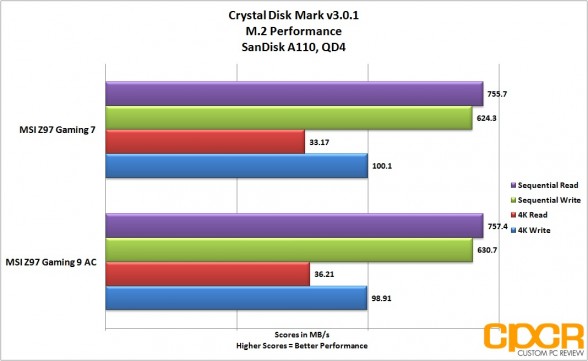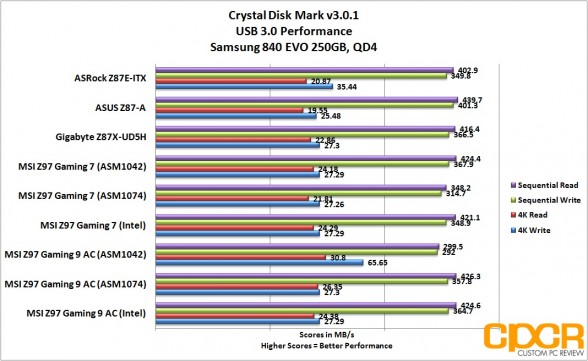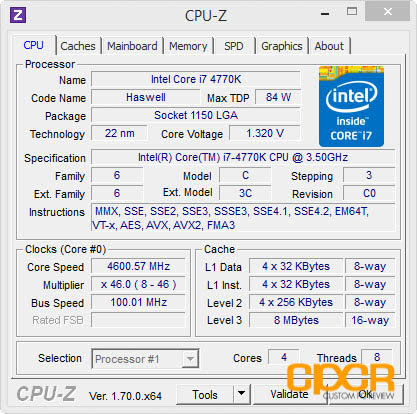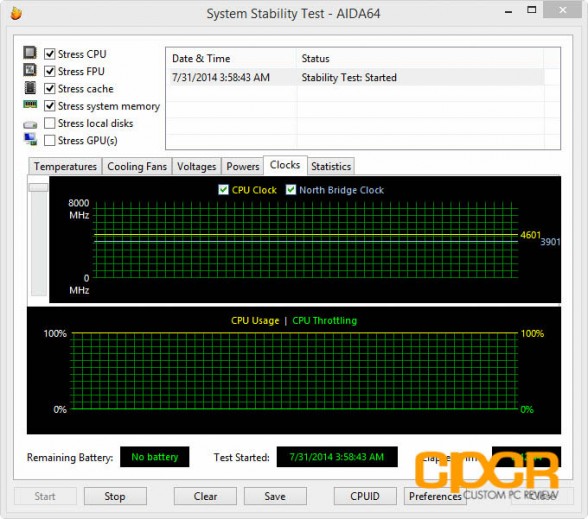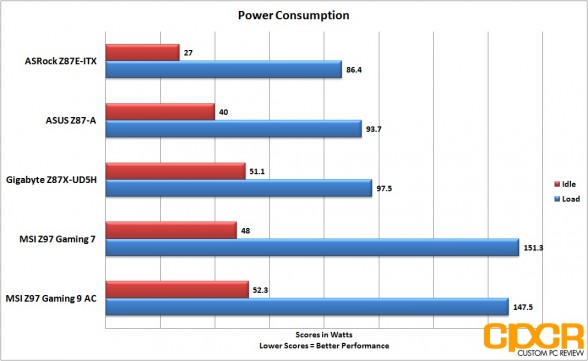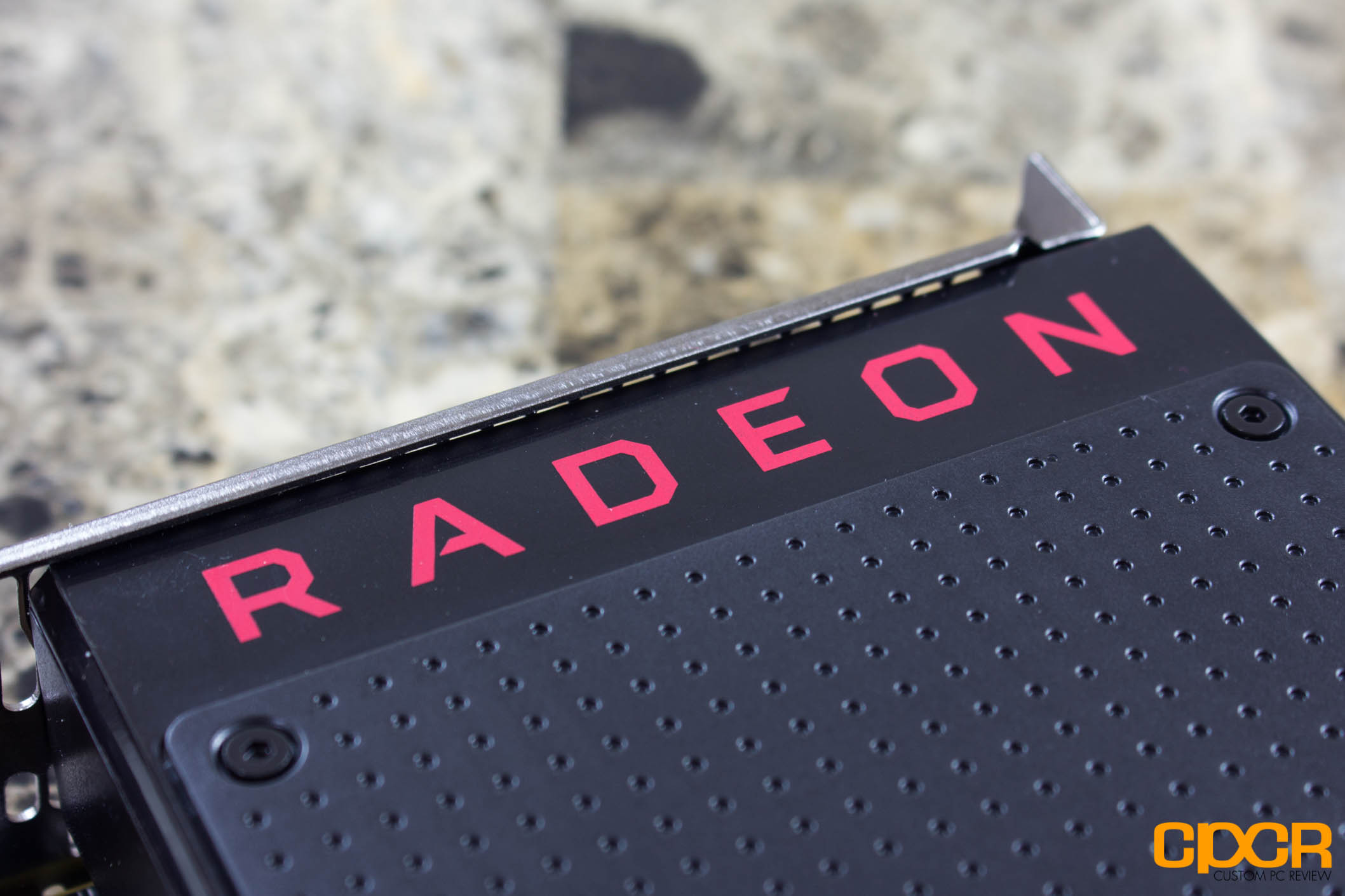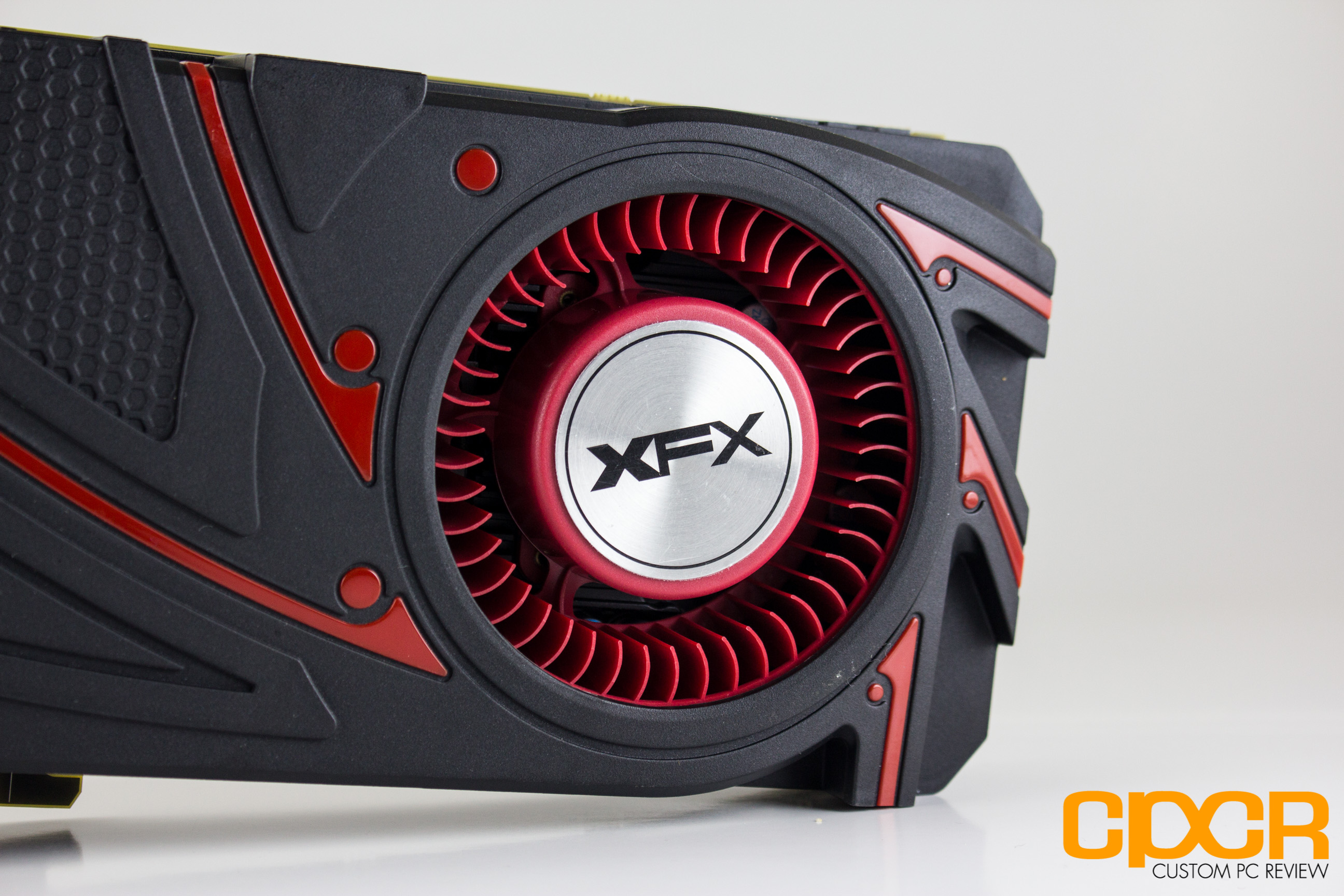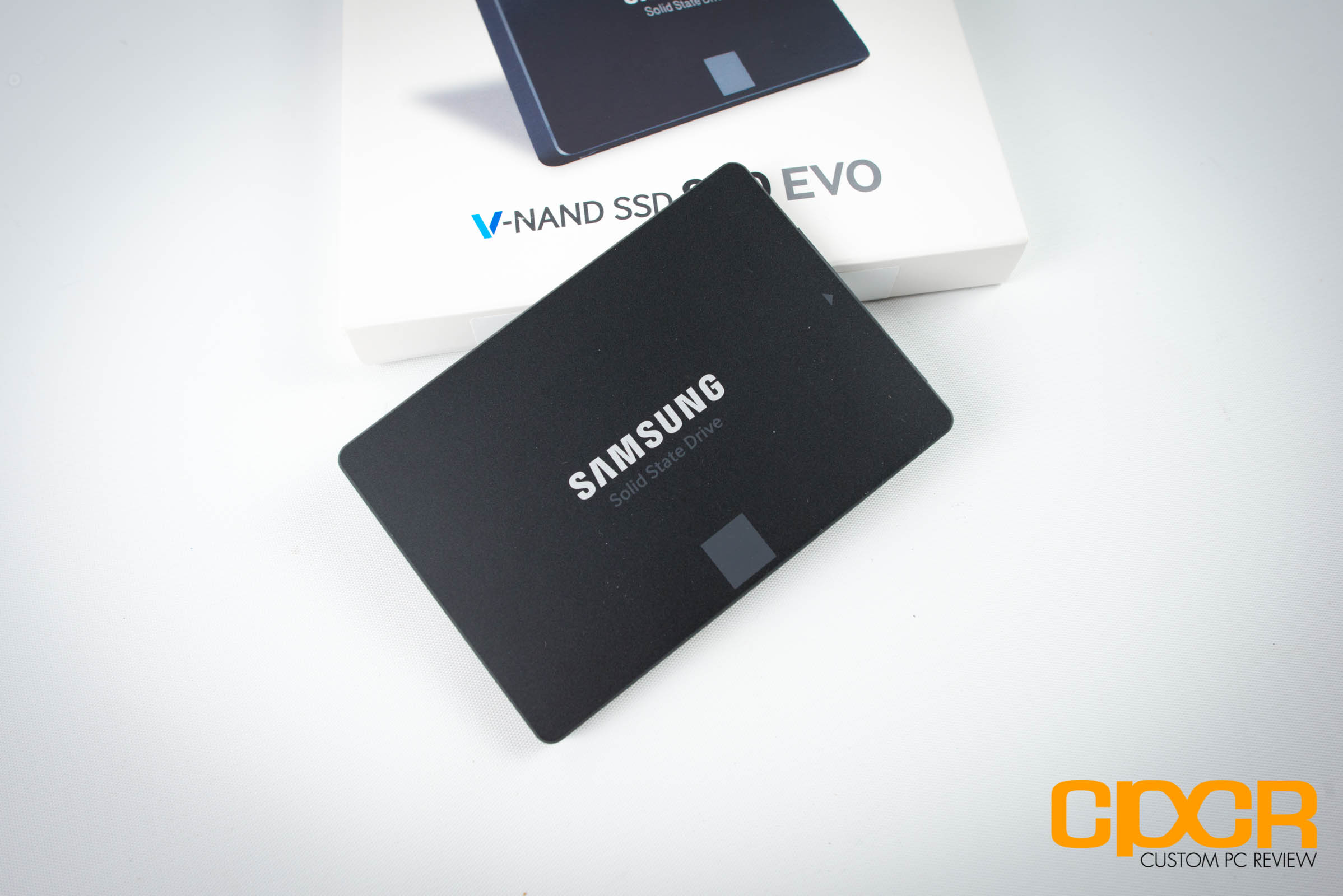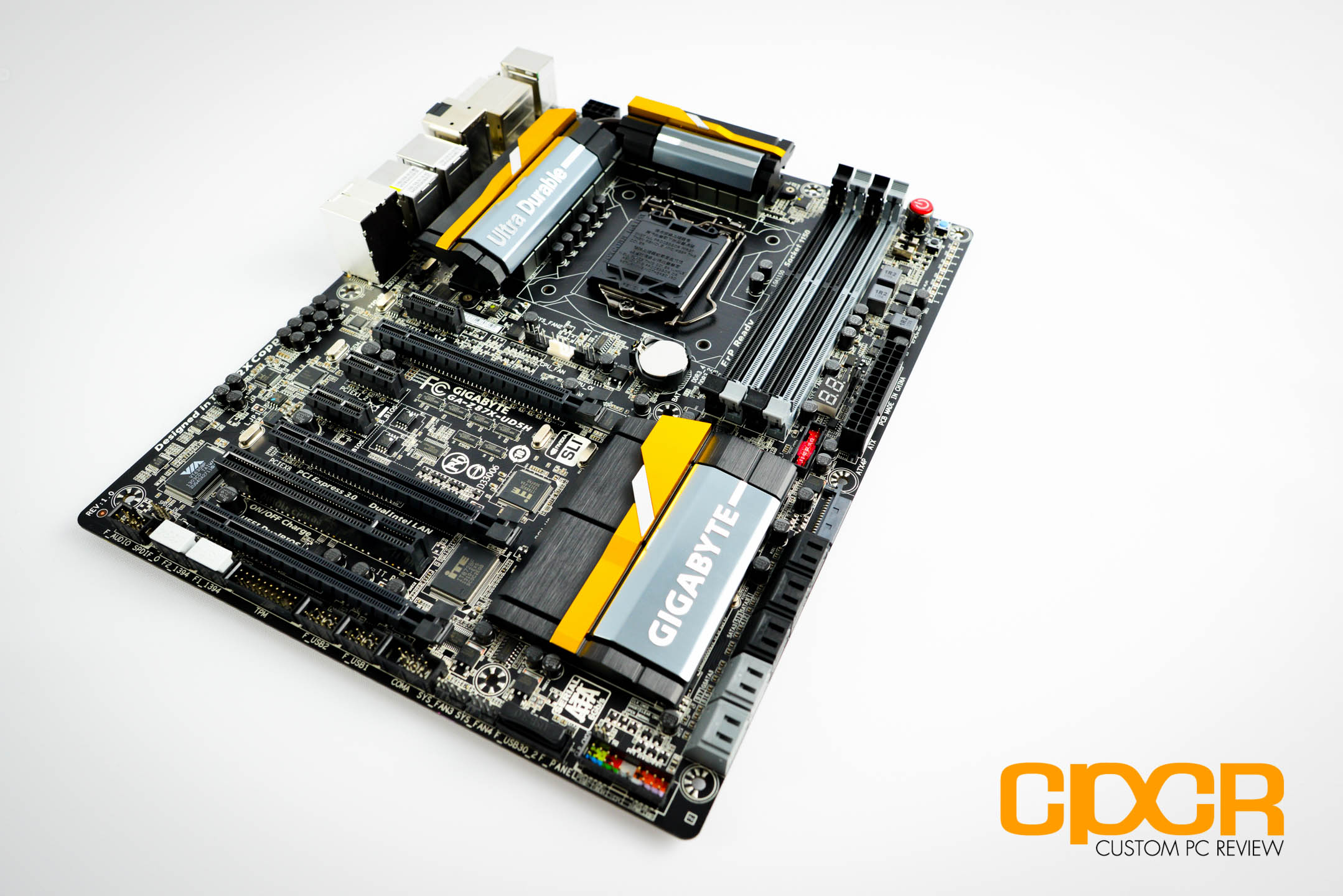[section label=1. Introduction]
MSI’s Flagship Gaming Motherboard
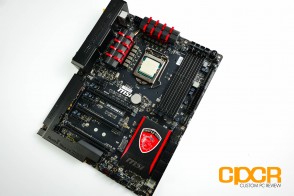 A couple months ago, we were fortunate enough to be one of the first tech review sites to get the opportunity to review the MSI Z97 Gaming 7 motherboard which we felt was one of the best all-around sub-$200 gaming motherboards. It was rock solid, had a fantastic layout, and a premium feature-set well worth its pricetag.
A couple months ago, we were fortunate enough to be one of the first tech review sites to get the opportunity to review the MSI Z97 Gaming 7 motherboard which we felt was one of the best all-around sub-$200 gaming motherboards. It was rock solid, had a fantastic layout, and a premium feature-set well worth its pricetag.
At the time of the review of the Gaming 7, MSI had already planned to release an even more premium gaming motherboard, the Z97 Gaming 9 AC, but it was still under wraps at the time. We were told however, that the MSI Z97 Gaming 9AC would be a wireless model and have a significantly upgraded audio system that would really differentiate it from the rest of the gaming lineup.
MSI Z97 Gaming 9 AC Specifications
| Manufacturer | MSI |
|---|---|
| Model | Z97 Gaming 9 AC |
| FormFactor | ATX |
| Socket | LGA-1150 |
| Chipset | Intel Z97 |
| Memory | 4x DDR3 DIMM Slots (Up to 32GB) Dual Channel, Up to DDR3 3300 (OC) |
| Video | Intel HD Graphics Discrete Graphics |
| Audio | Realtek ALC1150 7.1 Channel Audio CMedia CM6631A (JAUD1) Wolfson WM8741 DAC TPA6120A2 Amp 2x TI OPA1652 Amp (Headphone support up to 600 ohm) |
| LAN/WiFi | 1x Killer E2205 1x Intel Dual Band Wireless-AC 7260 (WiFi a/b/g/n/ac, Intel WiDi) |
| Slots | 1 x PCI Express 3.0 x16 slot @ x16 1 x PCI Express 3.0 x16 slot @ x8 1 x PCI Express 3.0 x16 slot @ x4 3 x PCIe 2.0 x1 slots |
| Storage | 6 x SATA3 6.0 Gb/s connectors (Intel Chipset) 2 x SATA 3 6.0 Gb/s connectors (ASMedia ASM1061 Chipset) 1x M.2 (PCIe x2 or SATA 6Gb/s) |
| Onboard Connectors | 1 x 24-pin ATX main power connector 1 x 8-pin ATX 12V power connector 8 x SATA 6Gb/s connectors 1 x M.2 port 2 x USB 2.0 connectors (supports 4x USB 2.0 ports) 2 x USB 3.0 connector (supports 4x USB 3.0 ports) 2 x 4-pin CPU fan connectors 3 x 4-pin system fan connectors 1 x TPM module connector 1 x Front panel audio connector 1 x Direct audio power connector 2 x System panel connectors 1 x Chassis Intrusion connector 1 x Clear CMOS jumper 9 x V-Check connectors 1 x Power button 1 x Reset button 1 x OC Genie button 1 x Multi-BIOS switch 1 x Audio power switch 1x Wi-Fi/Bluetooth module connector 1 x 2-Digit Debug Code LED |
| Rear Panel I/O | 1 x PS/2 keyboard/ mouse combo port 1 x Clear CMOS button 1 x LAN (RJ45) port 2 x USB 2.0 ports 8 x USB 3.0 ports 1 x Optical S/PDIF OUT connector 6 x OFC audio jacks 2 x HDMI port 1 x DisplayPort |
| Warranty | 3 Years |
| Check Pricing | Amazon |
As such, today we’ll be reviewing the MSI Z97 Gaming 9 AC which as you know is MSI’s top-of-the line gaming motherboard. As its name suggests, the board uses the Intel Z97 chipset and LGA1150 socket. While there haven’t been a whole lot of changes coming from the Z87 chipset, the Z97 chipset does has native support for new PCIe storage interfaces, M.2 and SATA Express, as well as support for Intel Haswell and upcoming Broadwell CPUs.
Similar to the Gaming 7, the Gaming 9 AC also supports up to 3x PCI-E 3.0 SLI/Crossfire, an upgraded audio subsystem, a plethora of connectivity options, and the much improved Click BIOS 4 UEFI interface. Unlike the MSI Z97 Gaming 7 however, MSI also upgraded the sound for the Z97 Gaming 9 AC even further by adding additional codecs, DACs, ADCs, etc. for the front-panel connector, and now includes an onboard Intel Wireless-AC 7260 chip (hence the AC suffix after the 9) with support for WIDI technology.
Let’s take a closer look!
[section label=2. A Closer Look]
A Closer Look at the MSI Z97 Gaming 9 AC
Here’s a look at the packaging for the MSI Z97 Gaming 9 AC.
As the Z97 Gaming 9 AC is MSI’s flagship gaming board, they haven’t skimped on the accessories at all, which required us to take four pictures just to fit everything in. Along with the documentation, we get a door hangar, case badge, cable labels, 7x SATA cables, SLI connector, rear I/O shield, M-Connector (front panel connector), V-check connector cables, SLI bridge, direct audio power cable, rear expansion slot SATA to eSATA adapter (2x eSATA ports), WiFi/BT module, and two antennas.
The MSI Z97 Gaming 9 AC motherboard is an ATX form factor motherboard which uses the Z97 chipset so it’ll support Intel socket LGA 1150 processors. Like the rest of MSI’s Z97 Gaming lineup, the Z97 Gaming 9 AC uses the gaming series black/red theme as well as an upgraded PCB which helps hide the copper traces onboard. This results in a more blacked out appearance than a brownish one seen on previous generation MSI motherboards.
The MSI Z97 Gaming 9 AC uses an Intel LGA 1150 socket so it’ll support Intel’s latest 4th Generation Intel Core processors (aka Haswell and Devil’s Canyon). It’ll also support Intel’s upcoming 5th Generation Core processors (aka Broadwell) which should arrive either at the end of this year or early next year.
VRM cooling is handled by new dragon claw inspired heatsinks which we recently saw from the Z97 Gaming 7. The heatsinks are no taller than heatsinks typically found on low profile memory, so large air coolers should not be an issue.
In total, MSI includes 5x 4-pin fan headers. 2x 4-pin fan headers (marked orange) are CPU fan headers while 3x 4-pin fan headers (marked green) are system fan headers. While it’s nice to see MSI include a full array of 4-pin fan headers, I feel like they should’ve included at least one more fan header.
Power delivery on the MSI Z97 Gaming 9 AC is handled by a 12+2 phase power delivery system which uses the ISL6388 digital controller, Hi-c Caps, Super Ferrite Chokes, and Dark Caps rated at up to 260ºC. This is the same power delivery system we saw on the MSI Z97 Gaming 7.
The MSI Z97 Gaming 9 AC support a maximum of 4x DIMMs of DDR3 DRAM with overclocked frequencies of up to 3,300MHz.
At the edge of the board, we get the usual 24 pin power connector, voltage check points, and onboard power/reset/OC Genie buttons.
For storage, MSI includes a total of 8x SATA 6Gb/s ports with 6x ports running off the Intel Z97 chipset and 2x running off an ASMedia ASM1061 chipset. Unfortunately, the ports aren’t color coded by controller type to help preserve the black/red color scheme.
New for the Z97 series is a M.2 slot located between the bottom two PCIe x16 slots. The M.2 slot is wired to support both SATA 6Gb/s and PCIe x2 based M.2 SSDs. It’s quite unfortunate however that if you decide to run a M.2 SSD, access to SATA ports 5 and 6 will be disabled – irregardless of if you plan on running a SATA or PCIe M.2 SSD. MSI does not include a SATA Express port with their Z97 series motherboards; however, MSI expects to offer a M.2 to SATA Express adapter down the line.
The MSI Z97 Gaming 9 AC includes two USB 3.0 headers powered by the Intel Z97 chipset. The USB 3.0 headers include re-drivers to increase the length of the cable you could use without signal integrity issues.
MSI includes 3x PCIe 3.0 x16 slots – one wired for x16, one wired for x8 and one wired for x4. There’s also three additional PCIe 2.0 1x slots for additional expansion options. Unfortunately, between the three PCIe x16 slots, there’s only a single space between each slot, which means there’s no room for those who wish to SLI triple slot graphics cards and there’s very little room to breathe for those planning on a multi-GPU configuration with dual slot GPUs.
Since Haswell + the Z97 chipset only include a total of up to 20 PCIe lanes, the top and middle PCIe x16 slot will operate in a x8/x8 configuration if two graphics cards are installed. If three cards are installed, the cards will run in an x8/x4/x4 configuration. The Z97 Gaming 7 is capable of supporting either two-way SLI or three-way CrossFire.
Near the bottom of the motherboard, we get two Winbond BIOS chips along with a DIP switch that allows switching between the primary and secondary BIOS. This lets users to recover the primary BIOS in the event of a corrupt BIOS.
Sensor monitoring is handled by the Nuvoton NCT6792D super I/O controller.
With the MSI Z97 Gaming 9 AC, one of the biggest features is the audio capabilities of the board. In fact it’s so important, that MSI has dedicated the entire bottom left section of the board to audio, which is easily identified with the Dragon Armor EMI (Electromagnetic Interference) shield, or the physically separated audio PCB.
Unlike most integrated audio systems, the MSI Z97 Gaming 9 AC’s onboard audio subsystem is split into two parts – Audio Boost 2 and Xtreme Audio DAC.
Audio Boost 2 is the the first part of the audio subsystem which is the powered by the Realtek ALC1150. This subsystem handles the six rear audio jacks. A pair of TI OPA1652 amplifiers then powers the front and rear audio outputs for high those wishing to use high impedance headphones. This is the exact same Audio Boost 2 subsystem included with the MSI Z97 Gaming 7 and also includes Direct Audio Power, gold plated audio connectors, Nichicon acoustic series capacitors, and USB audio power.
What’s different about the MSI Z97 Gaming 9 AC however, is significantly upgraded front panel audio which is not only completely separate from the rear panel audio, but is significantly upgraded. Called Xtreme Audio DAC, the front panel audio on the MSI Z97 Gaming 9 AC is powered by a C-Media CM6631A high definition audio processor – a fairly high end audio processor theoretically capable of up to a 120dB SNR and up to 192KHz/24-bit input/output audio processing capability. This is then connected to a Wolfson WM8741 DAC (digital to analog converter) and Cirrus Logic CS5346 ADC (analog to digital converter). The headphone portion also includes a TI TPA6120A2 amp which supports headphones up to 600Ω.
In testing, the rear panel audio was very good, especially compared to older motherboards. Electrical noise is eliminated and audio is much cleaner than typical of many other motherboards without Audio Boost 2 features. Front panel audio on the other hand was was at the mercy of the case. As front panel PCBs are generally not built for high end audio purposes, electrical interference from nearby USB ports caused interference with the audio which makes it just as bad as typical front panel audio from low end motherboards. In testing with multiple cases, I experienced everything from CPU whine, small low end buzzing noises from external hard drives, and even electrical noise when charging my phone. The only situation where this wasn’t a problem was when every cable from the front panel (power switch, reset switch, USB ports, etc.) were disconnected leaving the audio jacks as the only connection to the motherboard which obviously isn’t much of a solution. For Xtreme Audio DAC to work as intended, MSI really needs to provide some sort of dedicated front panel audio adapter for either in the expansion slots or the expansion bays to avoid this issue.
Here’s a look at the bottom edge of the MSI Z97 Gaming 9 AC. Here we get the front panel audio header, 2x USB 2.0 headers, TPM header, two fan headers, front panel headers, a BIOS toggle switch, and a LED debug screen.
Next to the SATA ports is a LED debug display which shows debug codes during POST and switches to CPU temperature once the board is booted up. A nice touch which can be extremely useful for those with windowed cases or open air test benches.
Looking at the rear I/O, we get a PS2 keyboard/mouse combo port, 2x USB 2.0 (gaming mouse/keyboard ports), 8x USB 3.0 ports (4x Intel Z87 chipset, 2x ASMedia ASM1074, and 2x ASMedia ASM1042), clear CMOS button, 2x HDMI, 1x DisplayPort, Killer E2205 LAN port, 7.1 channel gold plated audio jacks, and optical out.
Those wishing to use the WiFi/Bluetooth/WiDi can also install the WiFi/BT/WiDi module. Unfortunately doing so will require removal of the rear I/O cover and installation of the module will require some precision as the pins are extremely small and may be costly to fix if you’re not careful.
Flipping the board around the back, we can see MSI’s quality soldering and traces. Heatsinks are mounted via the preferred metal screws rather than cheap plastic tabs. Being one of MSI’s flagship boards, the MSI Z97 Gaming 9 AC is 6 layers thick.
Once powered on, we can see that MSI has outfitted the Z97 Gaming 9 AC with a couple pretty, subtle lights. Very nice.
[section label=3. UEFI]
MSI Z97 Gaming 9 AC UEFI
The MSI Z97 Gaming 9 AC uses MSI’s Click BIOS 4, which is MSI’s latest UEFI “BIOS” implementation. Since the UEFI is nearly identical to the MSI Z97 Gaming 7 reviewed previously, we’ll only be providing screenshots here. Be sure to refer to our review of the MSI Z97 Gaming 7 for more details.
[section label=4. Software]
MSI Z97 Gaming 9 AC Software
Like the UEFI, software on the MSI Z97 Gaming 9 AC is identical to the software on the Z97 Gaming 7, so I’ll simply be posting a couple screenshots of the software here. Those who’d like details can check out our review of the MSI Z97 Gaming 7.
MSI Command Center
Killer Network Manager
MSI ECO Center
MSI Super Charger
Fast Boot
Live Update
X-Split
[section label=5. Performance]
MSI Z97 Gaming 9 AC Performance
Haswell Testing Setup
| System | CyberPowerPC Gamer Xtreme 4200 |
|---|---|
| CPU | Intel Core i7-4770K (Fixed at 3.6GHz for consistency) |
| Motherboard | N/A |
| Memory | Kingston HyperX 10th Anniversary DDR3 2400MHz 16GB (4x4GB) Kit (2x4GB used) |
| Graphics | ASUS Radeon HD 7870 DC2 |
| Storage | Corsair Force GS 240GB & Samsung 840 EVO 250GB & SanDisk A110 256GB |
| Power Supply | Corsair HX650 |
| Case | HSPC High Speed Tech Station, Cooler Master Scout 2 Advanced |
| Optical Drive | ASUS OEM DVD Drive |
| Operating System | Windows 8.1 64 bit |
Special thanks to CyberPowerPC, Kingston, Corsair and HSPC for sponsoring our test bench!
CPU Performance
Cinebench R15
“CINEBENCH is a real-world cross platform test suite that evaluates your computer’s performance capabilities. CINEBENCH is based on MAXON’s award-winning animation software CINEMA 4D, which is used extensively by studios and production houses worldwide for 3D content creation. MAXON software has been used in blockbuster movies such as Iron Man 3, Oblivion, Life of Pi or Prometheus and many more.”
Memory Performance
AIDA 64
“AIDA64 Extreme Edition is a streamlined Windows diagnostic and benchmarking software for home users and enthusiasts.”
Graphics Performance
3D Mark
3D Mark is Futuremark’s latest benchmark utility used widely by gamers, enthusiasts, and overclockers to benchmark system performance and stability under consistent graphics loads.
Storage Performance
For storage performance testing, we’ll be using a fresh Samsung 840 EVO 250GB SSD for SATA and USB 3.0 testing. This will allow us to fully saturate the SATA 6Gb/s ports on the motherboards and for USB 3.0 testing, we’ll additionally be using the Thermaltake BlacX 5G USB 3.0 dock, which is one of the few USB 3.0 docks on the market that currently supports the UASP protocol. New for Z97 motherboards and beyond, we’ll also be using the SanDisk A110 M.2 PCIe x2 SSD, which will allow us to test the capabilities of motherboards with the M.2 interface.
SATA Performance
M.2 Performance
USB 3.0 Performance
Performance Analysis
Since motherboard CPU, memory, graphics performance is mostly tied to other components as well as the specific motherboard settings (frequency, BCLK, etc.), we’re mostly looking for our motherboard to be consistent in performance in comparison to other motherboards using the same components. Performance numbers on the MSI Z97 Gaming 9 AC was fairly consistent with the other motherboards tested here, so there doesn’t appear to be any problems.
As far as stability, I didn’t notice any issues with the motherboard in my testing. MSI’s power delivery systems are generally rock solid and the Z97 Gaming 9 AC was no exception.
[section label=6. Overclocking]
MSI Z97 Gaming 9 AC Overclocking
The MSI Z97 Gaming 9 AC uses the Intel Z97 chipset which supports overclocking of any K series Haswell or Devil’s Canyon processor.
Adaptive + Offset Overclocking
Since the MSI Z97 Gaming 9 AC and the Z97 Gaming 7 pretty much share their power delivery systems and the UEFI, overclocking was very familiar. For our overclocking, we simply hopped into the UEFI, switched the motherboard to manual mode, set the multiplier to 46x, set the vCore mode to Adaptive + Offset mode, and set the offset voltage to 0.10v. This automatically gave us a stable 4.6GHz at 1.320V.
Moving further, setting the multiplier to 4.8GHz wasn’t a problem either, but it did cause the system to throttle (Corsair H70), so we weren’t able to properly test for stability here. Those with slightly better cooling and a decent CPU should be able to push 4.8GHz without issue.
[section label=7. Power Consumption]
MSI Z97 Gaming 9 AC Power Consumption
Here we’ll be testing the maximum power consumption of each of the motherboards below. Idle power consumption is taken after the system is left idle for a minimum of 5 minutes. Load power consumption numbers are taken during a run of 3D Mark FireStrike, which will yield an accurate picture of how much power is drawn in a real world scenario.
In order to ensure that our power consumption measurements are as comparable as possible, all motherboards use out of the box settings in BIOS with the turbo multiplier locked at 36x and any power saving features such as C-states are turned on. The graphics card is also removed and the system is running off integrated graphics only to eliminate a discrete graphics card’s impact on power consumption.
All power consumption readings are taken using a Extech 380801 Power Analyzer connected via a Tripp-Lite LCR2400 Line Conditioner.
Performance Analysis
With the MSI Z97 Gaming 9 AC being so similar to the Z97 Gaming 7, we expected power draw to be fairly similar although slightly higher given that the board is slightly better equipped which is exactly what we saw. Power draw came in at ~4.3 watts higher at idle although ~3.8w lower at load. This is likely due to a newer, more efficient UEFI.
Like the Z97 Gaming 7, the MSI ECO Center software also works for the Z97 Gaming 9 AC; however, we weren’t able to get it working for some reason as shutting any of the subsystems off would cause system instability and ultimately a BSOD. That said, I doubt very many users of flagship boards are concerned about a the couple watts of power draw shutting off the M.2 port will save.
[section label=8. Conclusion]
MSI Z97 Gaming 9 AC Conclusions
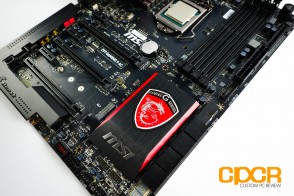 Alright, so with testing out of the way, let’s talk about the MSI Z97 Gaming 9 AC. First, the good things. It’s essentially a Z97 Gaming 7 with WiFi and Xtreme Audio DAC. As such, we get the same 12 phase power delivery system as the Z97 Gaming 7 which we had already found to be very good. The motherboard was rock solid during testing and aside from some overclocking issues prior to updating to the latest firmware (version 1.4), we didn’t have any issues with the board.
Alright, so with testing out of the way, let’s talk about the MSI Z97 Gaming 9 AC. First, the good things. It’s essentially a Z97 Gaming 7 with WiFi and Xtreme Audio DAC. As such, we get the same 12 phase power delivery system as the Z97 Gaming 7 which we had already found to be very good. The motherboard was rock solid during testing and aside from some overclocking issues prior to updating to the latest firmware (version 1.4), we didn’t have any issues with the board.
Design and layout of the MSI Z97 Gaming 9 AC is fairly good in some aspects, but lacking in others. Headers/connectors are well placed at the edges of the board to ensure clean, uncluttered cabling, 4-pin fan connectors all around are a nice touch, there’s plenty of room around the CPU for larger coolers, and the onboard lighting does make the Z97 Gaming 9 AC one of the best looking motherboards on the market.
However, MSI then decides to make a the WiFi/BT module a user installable item when it really should be pre-installed from the factory and gives the board a PCIe layout that makes it difficult to install graphics cards with triple slot coolers thanks to the massive onboard audio subsystem. While the massive audio subsystem is good on paper, in practice it’s not so great as well. MSI didn’t seem to account for that fact that most cases tend to use cheap, unshielded cables for the front panel audio. In testing, this caused tons of interference from all the electrical cables nearby making audio sound worse than most onboard sound systems out there. Not good.
The MSI Z97 Gaming 9 AC is currently available at various retailers for around $299.99, which prices it in the most premium category of motherboards on the market. I think this is a fair price given the features, but MSI does need to make some improvements to make the motherboard worthwhile. The first is simply to pre-install the WiFi/BT/WiDi module at the factory. Since most users go out and purchase a motherboard with WiFi built-in because they actually want to use WiFi, it makes a lot more sense to give users the option to remove the WiFi module rather than have it as an installable add-on. Second, I think MSI needs to give users a high quality front panel audio to 3.5mm headphone/microphone adapter that can be installed either in the expansion bays in the back of the case or in the optical drive bays. That way it allows users to avoid using the cheap cabling and interference prone front panel 3.5mm headphone/microphone jacks on cases.
Overall, MSI’s flagship Z97 Gaming 9 AC is a rock solid motherboard that needs some improvements to realize its full potential. Until then unless you really need WiFi, I’d consider stepping down to the Z97 Gaming 7 which has almost all the useful features of the Z97 Gaming 9 AC for $100 less.
Sample provided by: MSI
Available at: Amazon

